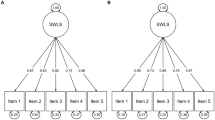Abstract
There is little empirical knowledge about the contribution of treatment effectiveness to patient satisfaction, particularly in the area of mental health. We conducted this study to assess the satisfaction of 3,646 veterans who received treatment from March 1996–April 1997 at specialized inpatient and residential posttraumatic stress disorder programs at Departments of Veterans Affairs in 35 locations. We used structural equation modeling to evaluate and extend a model of connections among pretreatment characteristics, treatment structure, treatment effectiveness and patient satisfaction. The results suggest three implications for mental health administration and program planning: (1) any valid comparison of programs requires that differences in patient characteristics be taken into account, (2) satisfaction and effectiveness are largely separate indices of quality, and (3) shortening the length of stay to contain cost is likely to lower patient satisfaction.
Similar content being viewed by others
REFERENCES
Attkisson, C.C., & Zwick, R. (1982). The Client Satisfaction Questionnaire: Psychometric properties and correlation with service utilization and psychotherapy outcome. Evaluation and Program Planning, 5, 233–237.
Bentler, P.M. (1989). EQS structural equations program manual. Los Angeles: BMDP Statistical Software.
Bollen, K.A. (1989). Structural equations with latent variables. New York: Wiley.
Card, J.J. (1983). Lives after Vietnam. Lexington, MA: Heath.
Carr-Hill, R. (1992). The measurement of patient satisfaction. Journal of Public Health and Medicine, 14, 236–249.
Cronbach, L. (1951). Coefficient alpha and the internal structure of tests. Psychometrika, 16, 297–304.
Edwards, D.W., Yarvis, R.M., Mueller, D.P., & Langsley, D.G. (1978). Does patient satisfaction correlate with success? Hospital and Community Psychiatry, 29, 188–190.
Fontana, A., & Rosenheck, R. (1993). A causal model of the etiology of war-related PTSD. Journal of Traumatic Stress, 6, 475–500.
Fontana, A., & Rosenheck, R. (1994). A short form of the Mississippi Scale for measuring change in combat-related PTSD. Journal of Traumatic Stress, 7, 407–414.
Fontana, A., & Rosenheck, R. (1997a). Effectiveness and cost of inpatient treatment of posttraumatic stress disorder. American Journal of Psychiatry, 154, 758–765.
Fontana, A., & Rosenheck, R. (1997b). Outcome monitoring of specialized intensive PTSD programs: Fiscal year 1996 report. West Haven, CT: Northeast Program Evaluation Center.
Fontana, A., Rosenheck, R., Spencer, H., Gray, S.,& DiLella, D. (1998). The long journey home VI: Treatment of posttraumatic stress disorder in the Department of Veterans Affairs—Fiscal year 1997 service delivery and performance. West Haven, CT: Northeast Program Evaluation Center.
Fowler, J.F., & Jackson, F. (1991). Comparing prospective and retrospective: Measures of treatment outcomes. University of Massachusetts, Boston: Center for Survey Research.
Foy, D.W., Sipprelle, R.C., Rueger, D.B., & Carroll, E.M. (1984). Etiology of posttraumatic stress disorder in Vietnam veterans: Analysis of premilitary, military, and combat exposure influences. Journal of Consulting and Clinical Psychology, 52, 79–87.
Greenwood, N., Key, A., Burns, T., Bristow, M., & Sedgwick, P. (1999). Satisfaction with in-patient services: Relationship to patient and treatment factors. British Journal of Psychiatry, 174, 159–163.
Hatcher. L. (1994). A step-by-step approach to using the SAS system for factor analysis and structural equation modeling. Cary, NC: SAS Institute, Inc.
Hayduk, L.A. (1987). Structural equation modeling with LISREL. Baltimore: Johns Hopkins University Press.
Hermann, R.C., Ettner, S.L., & Dorwart, R.A. (1998). The influence of psychiatric disorders on patients' ratings of satisfaction with health care. Medical Care, 36, 720–727.
Hoff, R.A., Rosenheck, R.A., Meterko, M., & Wilson, N.J. (1999). Mental illness as a predictor of satisfaction with inpatient care. Psychiatric Services, 50, 680–685.
James, L.R., Mulaik, S.A., & Brett, J. (1982). Causal analysis: Models, assumptions, and data. Beverly Hills, CA: Sage.
Kane, R.L., Maciejewski, M., & Finch, M. (1997). The relationship of patient satisfaction with care and clinical outcomes. Medical Care, 35, 714–730.
Kasprow, W.J., Frisman, L., & Rosenheck, R.A. (1999). Homeless veterans' satisfaction with residential treatment. Psychiatric Services, 50, 540–545.
Kulka, R.A., Schlenger, W.E., Fairbank, J.A., Hough, R.L., Jordan, B.K., Marmar, C.R., & Weiss, D.A. (1990). Trauma and the Vietnam war generation: Report of findings from the National Vietnam Veterans Readjustment Study. New York: Brunner/Mazel.
Laufer, R.S., Yager, T., Frey-Wouters, E., & Donnellan, J. (1981). Legacies of Vietnam (House Committee print 14). Washington, DC: U.S. Government Printing Office.
Lebow, J.L. (1983). Research assessing consumer satisfaction with mental health treatment: A review of findings. Evaluation and Program Planning, 6, 211–236.
Linder-Pelz, S. (1982). Toward a theory of patient satisfaction. Social Science and Medicine, 16, 577–582.
Mardia, K.V. (1970). Measures of multivariate skewness and kurtosis with applications. Biometrika, 57, 519–530.
McLellan, A.T., Luborsky, L., Cacciola, J., Griffith, J., Evans, F., Barr, H.L., & O'Brien, C.P. (1985). New data from the Addiction Severity Index: Reliability and validity in three centers. Journal of Nervous and Mental Disease, 173, 412–423.
Mulaik, S.A., James, L.R., Van Alstine, J., Bennet, N., Lind, S., & Stilwell, C.D. (1989). Evaluation of goodness-of-fit indices for structural equation models. Psychological Bulletin, 105, 430–445.
Pascoe, G.C. (1983). Patient satisfaction in primary health care: A literature review and analysis. Evaluation and Program Planning, 6, 185–210.
Priebe, S., & Gruyters, T. (1995). Patients' assessment of treatment predicting outcome. Schizophrenia Bulletin, 21, 87–94.
Rosenheck, R., Wilson, N.J., & Meterko, M. (1997). Influence of patient and hospital factors on consumer satisfaction with inpatient mental health treatment. Psychiatric Services, 48, 1553–1561.
SAS Institute Inc. (1989). SAS/STAT user's guide, Version 6, 4th Ed., Vol 1. Cary, NC: SAS Institute, Inc.
Author information
Authors and Affiliations
Rights and permissions
About this article
Cite this article
Fontana, A., Rosenheck, R. A Model of Patients' Satisfaction with Treatment for Posttraumatic Stress Disorder. Adm Policy Ment Health 28, 475–489 (2001). https://doi.org/10.1023/A:1012270625680
Issue Date:
DOI: https://doi.org/10.1023/A:1012270625680




